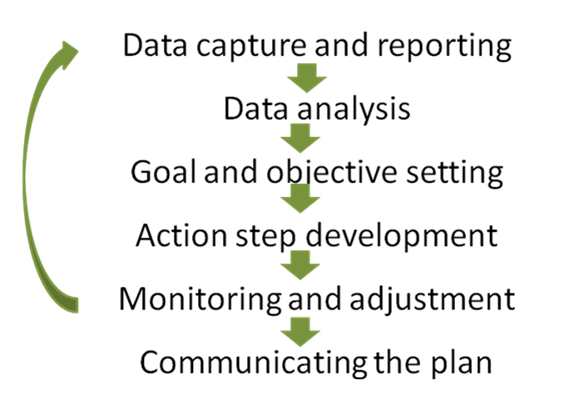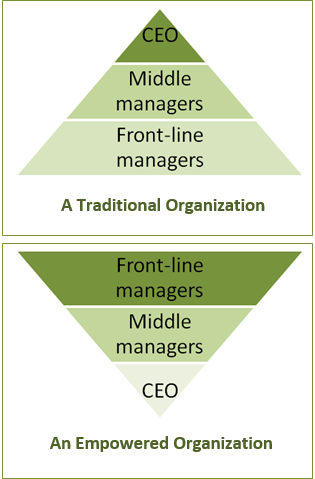Leading
School Improvement
- Senior Executive Lead Coaches: Drs. Harvey W. Perkins, Laurie Fanello, Kathy Kubic, Patricia Leary
- Grade Bands: All
- Delivery: In-Person (preferred), Hybrid, Virtual
- Specialized to a Population: No
- Audience: Teachers, Principals, Other School- and District-Level Administrators

The Six Steps To Success
The route to success will take you through the six critical steps of a Successful School Improvement Plan:
- Data capture and reporting
- Data analysis
- Goal and objective setting
- Action step development
- Monitoring and adjustment
- Communicating the plan
Note that these steps have bullets next to them, not
numbers. That’s because while there is a logical sequence to activities, it is
not simply a matter of working from 1 to 6 and then you’re done.
Consider the last item in the list: communicating the plan. Certainly,
you must devise an action plan before you can broadcast it to the world. The
process of developing and implementing plans that result in transformational
change, however, can’t be done in a principal’s office. It must be done in meeting
rooms, with people from all parts of the school around the table. Stakeholders must
be right there from the data gathering and analysis to the goal setting and
plan development, and of course for the monitoring and adjustment the plans. In
other words, staff are not the recipients
of a fully hatched plan communicated to them as the final step in a process.
They are active and essential participants
in the design of the plan.
Introduction to the six steps to success
Step 1: Data Capture and Reporting
Begin at the beginning: By looking at where your school is now. The first step is to collect and organize information that provides direction for the development of new strategies and action steps. Two types of data are needed. One is historical data related to academics, the school environment and community collaboration. The second is information about the perceptions, experiences, beliefs, and values of members of the school staff, which will be gathered by way of surveys.
Step 2: Data Analysis
With the data collected and tabulated, the focus shifts to determining what it means. Here you will look at trends over time, indicators of strengths and weaknesses, and evidence of how experiences and outcomes vary for different groups within your school.
Step 3: Goal and Objective Setting
In this step you formulate the goals that will take you from where you are now to where you want to be, as summed up in your vision and in the expectations and targets set for you by your state and school district. Then, you break those goals down into annual objectives that will focus your school’s attention on the next step forward and the year ahead.
Step 4: Action Step/Task Development
This step brings you deep into the “how” of achieving your goals. You lay out the specific actions, activities, programs, and strategies you will undertake to reach your objectives. This is your activity plan.
Step 5: Monitoring and Adjusting the Plan
Simply stated, “What gets measured gets done!” For that reason, one of the key pieces of your improvement plan will be determining how you will monitor that the activity is undertaken and whether it is effective. Under this monitoring component, you spell out what process information the team will collect throughout the year to ensure that the action steps listed are being carried out and when interim reports on the progress of action steps will be reported to the faculty. Remember, less is more, and your plans will focus on your mission-critical needs. The purpose of limiting the action steps to a few well-researched strategies is to increase the likelihood that they will actually be delivered, consistently and conscientiously. If interim data is collected that suggests the strategy should be modified, the team should make adjustments as soon as possible. You certainly do not want to keep following a failing strategy simply because it’s written into a plan.
Step 6: Communicating the Plan
The school improvement plan you develop will be the cornerstone of your school’s communication to both internal and external audiences throughout the year. Daily and weekly communications to staff should include reminders and updates on the plan and its action steps. Grade level, team and department meetings need to focus on the new interventions spelled out in the plan. Monitoring dates and process data should be a part of the regular dialogue that takes place in your building.
The kind of change that transforms the spirit and
performance of an organization can only happen if the day-to-day dialogue keeps
the change strategy alive — and top of mind as people go about their work. Communicating
the plan and its progress in creative and engaging ways can make the difference
between failure and success.
External publics need to be aware of the school’s commitment
to excellence and how it is working to attain its goal. Business and community
partners need to know that the school is on a continuous improvement journey
and specifically what the targets are for each year. Often these partners can
provide incentives and support for strategies in the plan.
Parents can be more supportive of school efforts if they are
aware of specific initiatives to increase student achievement or create a safer
learning environment. Use your school improvement plan as a public relations tool
whenever possible.
Critical Notes on School Change:
Reform is not a “once and done” undertaking. It can’t be.
Altering anything as complex as a school is far too complicated a process. It
would be naïve to think that the first intervention could resolve matters once
and for all. Systems are complex. Players change. New demands materialize. A thoughtfully
planned and well-executed intervention will get change off to a good start, but
two things are necessary: to monitor the effects it has, and to take corrective
and additional action as needed.
The approach laid out here is more looping than linear. Consider,
for example, being where you’ll be soon: You have worked through the first
points on the Successful School Action Plan sequence outlined above, you have a
plan in the “live” stage, and you’re monitoring how it is working. You’ll have
to capture and analyze data to gauge its effect, which takes you back to the
first and second bullet points. Depending on what your analysis shows, you may adjust
your objectives (the third point), revise your action plan (the fourth) and
cycle through the process all over again.

The process is a feedback loop,
not a straight line. The decision of what interventions to make is based on detailed
assessment of where the school is now. Those interventions change where you
are. You must continually assess to determine both how well an intervention is
working and what you should do next.
For example, if your
self-diagnosis indicates that there is a lack of alignment between curriculum
and assessment in mathematics, you will work to bring what you teach in line
with what students are assessed on. To see whether the alignment has had the
desired effect, it will be necessary to look at whether there’s a change in the
assessment results. The next round of math tests might indicate, for example,
that after revising what is taught, students are doing better with math
operations but still have trouble with applications. That will point to the
need to go back, figure out whether the problem is with curriculum or
instructional methods, and make the necessary changes — and check to see what
the effect is.
Similarly, you might find in your
initial self assessment (as many schools do) that some teachers have different
expectations of different groups of students. After you have addressed this,
through attention to the moral code and professional development, you will need
to reexamine achievement and behavior data to see if there has been a change.
If there is any group that
understands this iterative, data-driven assessment loop, it’s educators.
Through assignments, questions, quizzes, tests and observation, teachers
continually check whether children are mastering the skills and information being
covered. Where there are problems, teachers circle back and address the need —
at least they do in effective schools.
The process of school reform is
similar. Assess, intervene, reassess, and respond. Repeat as necessary.
That’s how schools move from a chaotic
atmosphere to an orderly environment and on to one that is truly nurturing and
challenging. It’s how schools move from having too many students who barely make
it over the academic bar to having many who soar above the bar at a high level.
It’s how schools move from an environment in which teachers feel demoralized to
one where they are eager to join the team.

Change Takes Time.
Re-assessment does not always reveal the need to keep
fine-tuning an action plan. Sometimes it reveals that an intervention, whether
it focuses on teaching reading or on character development, has been
successful. Then it’s time to move on to the next challenge.
For most schools, becoming truly successful in a
standards-based environment is not a one-round, one-year process. It is a multi-year
process.
The process laid out in this guide will help you decide
where your biggest and most immediate needs area, where to concentrate first.
Once those issues are addressed, you will move on to other needs that weren’t
as pressing but must be addressed if you and your students are to be as
successful as you can be. Because schools’ rhythms are driven by an annual
calendar, it makes sense to set big goals and then break them down into annual
objectives and plans.
Less Is More
With all the demands on schools,
demands that will only heat up as state standards and the accountability they
bring start driving daily life, it’s essential that any tools held out to educators
be efficient as well as effective.
That is one of the key features
of the proven model for school success — the SAME Model, for Social, Academic
and Moral Education — and the process for implanting it. It helps schools concentrate
on their priorities and avoid wasting energy and resources on interventions
that are not mission critical.
Time is a limited resource, and
so are money, staff energy, and the number of things that can really be
priorities. It only makes sense to work in ways that maximize the return on the
investment and involvement of all the stakeholders in school reform.
Getting Your Team On Board
A leader cannot “fix” a school. Only a school can fix a school — although certainly, leadership is essential to their ability to do so.
The secret to developing a plan that will make meaningful and sustained change in your school, and for your students, is working with your teachers and other staff.
That doesn’t mean turning the process over and hoping for the best. Transforming your school, and how it works for the adults and the children in it, is a complex process … and the stakes are high. It is a process that will require both inspiring leadership and attentive, skilled management. It would be nearly impossible to overstate the importance of effective leadership on the part of the principal and other key school-level leaders. Change is not a linear process — but it is a collaborative one.
It also would not be possible to overstate how important it is that that leadership be exercised within a distributed leadership environment. That is one in which the shaping and doing of the work, the accountability and obligations, are shared not just among those in the school office, but by everyone on staff.
Distributed leadership is an essential part of the Social, Academic and Moral Education Model. ULLC coaches will explain the rationale and value for sharing responsibility for a school, providing information about what it looks like when it’s in place, why it’s so rewarding to work in such an environment, and how to bring it to life in your school. Before you can tackle the moral, social and academic aspects of your school, you have to start with a spirit of collaboration and shared responsibility, and you have to develop a team.
You must move from a traditional organization to an empowered organization; the difference is visible in a glance in the accompanying images as the organizational pyramid is turned upside down in and the weight becomes concentrated on front-line, not in the executive office.
Your school’s plan and the strategies for implementing it must be developed, collectively, by staff — in a process guided and facilitated by the principal. They cannot be imposed, top-down, in a dictatorial fashion from the front office. Teachers and other staff must feel that they are an essential part of the process, and they must act like they’re an essential part of the process — they must truly “get it,” where “it” is the necessity of, the opportunity for and the approach to school-wide transformation.
This approach isn’t bottom-up any more than it is top down. It is one in which the bottom and top work together toward a mutually productive middle. That ensures that your plan is informed by the in-depth understanding of students and colleagues that those on the front line of education — the classroom — bring to the process.
It also ensures that they have an investment in making the plan, their creation, work. It means that it has a higher probability of success than a plan that comes down from on high.
The most effective way to think of the school leader’s role is “coach.” That term pulls together all the implications of leadership and management, along with the critical jobs of inspiring the team, developing their skills, getting them working together, keeping them focused — and calling strategy. ULLC coaches will provide you with material to help you present information to your team and lead them through the process of assessing your school’s needs and developing plans and strategies to address them.
As you put together your team, be sure to include:
- People from all corners of your school: classroom and resource teachers from all grades and content areas; and from regular, special and gifted or honors education; guidance counselors and social workers; nurses; and support staff.
- A representative mix across gender, ethnicity, and age.
- Change agents who can help bring their wait-and-see colleagues along.
- Your most effective teachers, as evidenced by the performance of their students and their skilled use of a variety of instructional and assessment methods.
- Teachers who are successful with challenging students, especially disadvantaged and minority students and those who present classroom management problems.
- Teachers who aren’t as successful, so the strategies that are planned can be responsive to their needs.
- Staff members who are committed to the goal of a high-performing school.
- Your school’s opinion leaders. Consider including resistors as well as champions of change. It may be better to have potential naysayers at the table, where they can feel like they have some investment in the change process, then behind closed doors talking against it.
- Parents.
- Representatives of the community served by your school, including the business community.
- In high schools, at least one student representative.
[if !mso][endif]The principal can designate some of the work, but not the title of head coach. The principal’s role is to:
- Communicate a clear and compelling vision of excellence for your school.
- Set clear goals for the process and communicate an unflinching commitment to attaining them.
- Keep the focus on action, so the effort doesn’t stall out or devolve into “process” instead of outcomes.
- Articulate and reinforce a commitment to high standards of all — students, teachers, and administrators.
- Be a facilitator, model, and inspirer of the process of inquiry, of taking a hard look at where your school is now, what it could be and how to get there.
- Ask leading questions instead of prescribing answers.
- Be the chief cheerleader and celebrator of achievements, even small steps toward big goals.
- Be the truth teller and keep people from taking refuge in platitudes and pretences, in excuses and justifications for performance that falls short of what it should be. Ask hard questions and direct attention to hard truths.
- Promote the spirit of collective inquiry, collective responsibility, and collective decision-making. Make the process welcoming and meaningful to participants.
- Model, expect and insist on a process that is inclusive of all school members.

As the team begins work, it can
add people for specific activities, like gathering and analyzing data or
planning academic interventions. With a core team to provide stability, drawing
people in will help increase the number of people who have an investment in the
plan — and its success.
The core team should meet at
least monthly, although more frequent meetings may be needed during times of
intense activity, such as when the mission and vision statements are being
ironed out. Even after the action plans are developed and in place, monthly
meetings will be necessary for monitoring and fine-tuning as the plan goes
“live.”
Meetings should be held at
various times to accommodate staff, parents and community representatives.
Minutes should be prepared and distributed to all faculty and staff to keep
them in the loop and encourage engagement and dialogue.
ULLC has developed a rubric by which schools can measure
their current effectiveness in school improvement planning. This provides a
yardstick for school leaders to analyze current practices and point to areas where
the ULLC coach can provide direction going forward.
